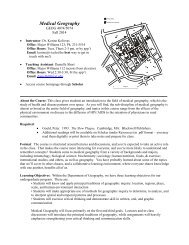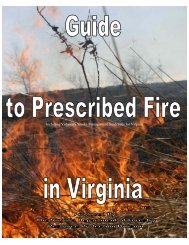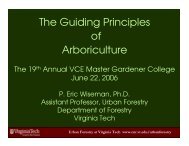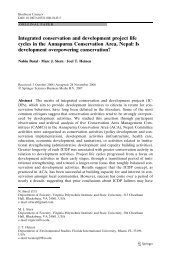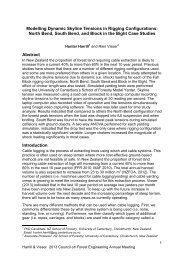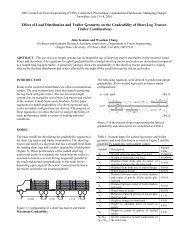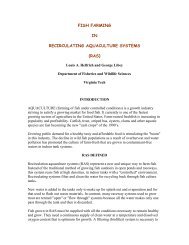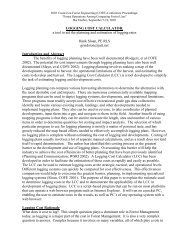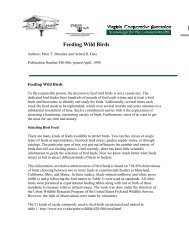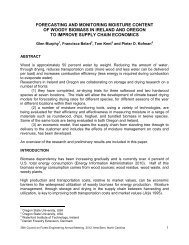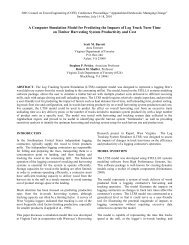1 Establishing a standard work sampling method for mastication ...
1 Establishing a standard work sampling method for mastication ...
1 Establishing a standard work sampling method for mastication ...
You also want an ePaper? Increase the reach of your titles
YUMPU automatically turns print PDFs into web optimized ePapers that Google loves.
leaving a mat of shredded wood on the soil surface (Jain et al. 2007). Mastication is an<br />
alternative <strong>for</strong> fire hazard reduction when the treatment area cannot be burned, mechanical<br />
removal of excessive fuels is cost prohibitive, or impacts on soil and sedimentation are of<br />
concern (Coulter et al. 2002; Rummer et al. 2003; Hatchett et al. 2006; Han et al. 2006; Kane et<br />
al. 2009).<br />
There are a variety of <strong>method</strong>s that can be employed to analyze the cost and evaluate operational<br />
efficiency of <strong>for</strong>est operations. Among <strong>method</strong>s, the detailed time and motion study <strong>method</strong><br />
using a stopwatch <strong>work</strong>s well in evaluating cyclic activities where there is a repetitive defined<br />
course of events (Olsen and Kellogg 1983). The <strong>work</strong> <strong>sampling</strong> <strong>method</strong> is less commonly used,<br />
but can be effectively used to evaluate non-cyclic activity such as <strong>mastication</strong> (Pape 1992;<br />
Bolding 2009 personal comm.) Work <strong>sampling</strong> consists of a series of consecutive observations<br />
where the current activity of the machines is documented (Heiland and Richardson 1957; Miyata<br />
1981; Olsen and Kellogg 1983; Pape 1992; Liao and Pape 1996; Bolding 2006).<br />
There are certain advantages and limitations to <strong>work</strong> <strong>sampling</strong> when compared to detailed time<br />
and motion studies. Among the advantages, the most poignant include: the ability to control the<br />
accuracy by increasing the number of observations, data reduction and analysis are easier and<br />
less time consuming, and the data can often be collected by one researcher who requires less<br />
training than necessary <strong>for</strong> time and motion studies (Miyata et al. 1980). Despite the advantages,<br />
<strong>work</strong> <strong>sampling</strong> is not always correct choice as it does not record machine cycle times and may<br />
report uncharacteristic proportions if the machine cycle and observation interval coincide. Also,<br />
important events between observation times may be missed and short delays may be reported<br />
incorrectly with increase in interval length (Olsen and Kellogg 1983). Among the several <strong>work</strong><br />
<strong>sampling</strong> <strong>method</strong>s, there is ambiguity as to which <strong>method</strong> is the best to evaluate masticators.<br />
The objective of this study was to establish a <strong>standard</strong> <strong>work</strong> <strong>sampling</strong> <strong>method</strong> <strong>for</strong> <strong>mastication</strong><br />
operations analysis, allowing researchers and land managers to evaluate operations efficiency<br />
and conduct fair cost comparisons. This <strong>method</strong> should aid in making in<strong>for</strong>med decisions<br />
resulting in efficient use of masticators to accomplish fuels treatment objectives in a costeffective<br />
manner. Our main approach was to compare various <strong>work</strong> <strong>sampling</strong> <strong>method</strong>s to a<br />
reference <strong>method</strong> to identify a <strong>work</strong> <strong>sampling</strong> <strong>method</strong> that provide the most accurate details on<br />
<strong>mastication</strong> operations with a minimum ef<strong>for</strong>t and time.<br />
Methods<br />
Study sites and <strong>mastication</strong> treatments<br />
Mastication <strong>for</strong> fuel hazard reduction was implemented at Humboldt State University’s L.W.<br />
Schatz Demonstration Tree Farm, located near Maple Creek in northwestern Cali<strong>for</strong>nia. Steep<br />
topography and availability of brush fields limited the area suitable <strong>for</strong> operation to nine small<br />
units of similar slope and fuel load conditions (Table 1). The areas selected were dominated<br />
primarily by a dense cover of shrub species such as pacific poison oak (Toxicodendron<br />
diversilobum (Torr. & A. Gray) Greene), blue blossom (Ceanothus thyrsiflorus Eschsch.), and<br />
coyote brush (Baccharis pilularis DC.).<br />
2






